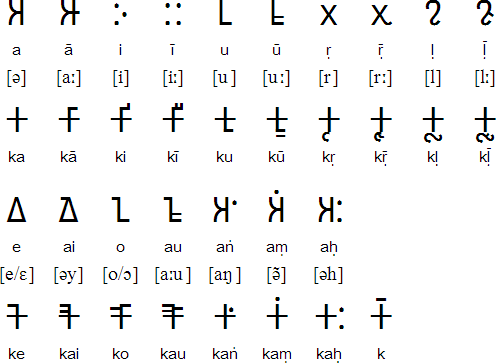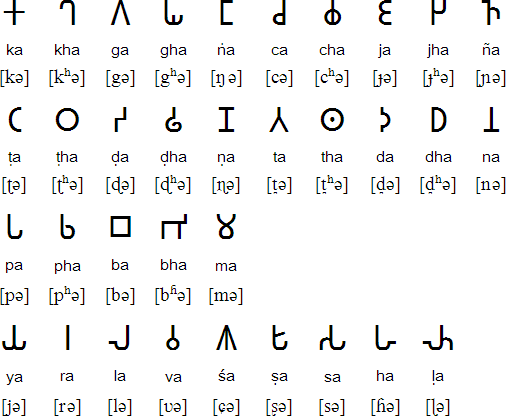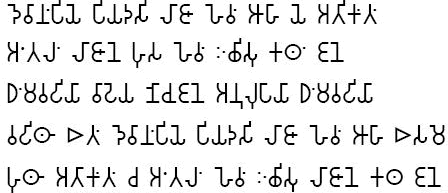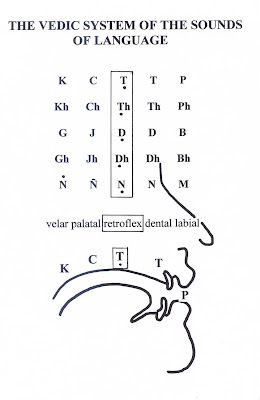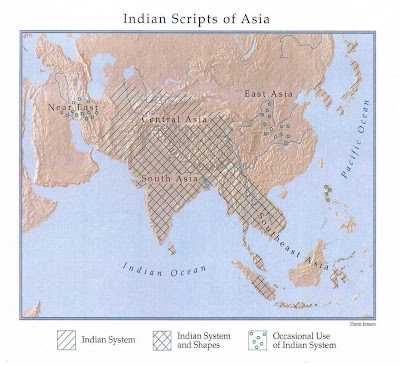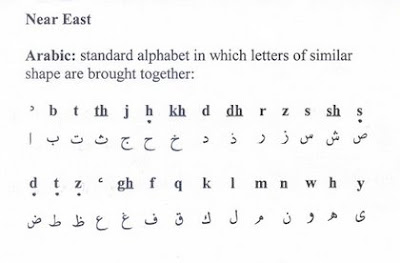Mirror: http://tinyurl.com/olmcl9k
In my view, Sarasvati script has virtually no influence on orthography of symbols used on Kharoṣṭhī and Brāhmī scripts. The possible reasons are:
1. Sarasvati (Indus) script is logographic and provides hieroglyph multiplex texts read (in mlecchita vikalpa or meluhha cipher) as catalogues related to metalwork. The thesis is that Indus Script Corpora is catalogus catalogorum of metalwork of Bronze Age.
2. There are no orthographic comparators to suggest link of the first syllables of metalwork words with the syllabic symbols of Kharoṣṭhī and Brāhmī scripts.
3. Though the ligaturing principle followed on Sarasvati (Indus) Script is followed in Kharoṣṭhī and Brāhmī syllabic symbols (i.e. by modifying basic consonants with vowel a endings by diacritical ligatures to connote other vowel endings: A, i, I, u, U, e, ai), the basic orthography of the symbols used in the two scripts of Kharoṣṭhī and Brāhmī bear only hazy resemblance to any of the hieroglyphs deployed on Sarasvati (Indus) script.
4. Unfortunately, the Vikramkhol inscription which seems to contain Sarasvati (Indus) script hieroglyphs of both a pictorial motif (animal) and sign (bellows) the letterings are not legible, because of eroded stone engravings, though the animal + bellows hieroglyphs identified by KP Jayaswal are indicative of record of metalwork.
The available evidence thus seems to indicate that the prototypes for Kharoṣṭhī and Brāhmī scripts are likely to be alphabetic scripts such as Aramaic, Phoenician -- adapted with ligatures to signify Meluhha (mleccha) syllables.
http://bharatkalyan97.blogspot.in/2015/07/indus-script-hieroglyphs-have-virtually.html Mirror: http://tinyurl.com/nefomgf
Contra arguments are gleaned from Subhash Kak and BV Subbarayappa which are presented on this note. Further reviewing their arguments, I see no reason to revise my earlier hypothesis that Sarasvati (Indus) script has virtually no influence on Kharoṣṭhī and Brāhmī scripts including representation of numerals in these two syllabic scripts.
In Subhash Kak's view, "primary Brāhmī signs look closes to the Sarasvati signs. many of the Brahmi signs are the first syllables of familiar objects: thus, g, ch, m, s', h appear to have been derived from the representations of giri (hill), chatra (umbrella), matsya (fish), s'ara (arrow), and hasta (hand)...Unfortunately, the phonetic values for the most frequent Sarasvati signs do not help us in reading most of the seals and other texts. The reason for this is that the short lengths of these texts disallows unambiguous readings." (p.379, 382)
Subhash Kak compares Sarasvati sign (hieroglyph 'fish') to syllable m in Brāhmī:
He further argues: "The Brāhmī 10 before the advent of zero was written as a fish sign, or the sign for m, lying sideways. In later forms it was also written with a single curving stroke, or with vertical stroke attached to a circle. It appears thatthe shape of zero was determined by the oval related to the fish sign of the Brāhmī 10. In such a representation, the zero sign clearly had the null (s'Unya) value which explains its name." (P.384)
Contrasted with this are the sets of numeral symbols of Kharoṣṭhī and Brāhmī, none of which bear any resemblance to 'fish' symbol variants recorded in Brāhmī:
![]() Brahmi numerals
Brahmi numerals![]()
There is, however, a possibility that numerals were acrophonic and based on the Kharosthi alphabet. "For instance, chatur 4 early on took a Y shape much like the Kharoṣṭhī letter ch, panca 5 looks remarkably like Kharoṣṭhī p; and so on through shat 6, sapta 7, and nav 9 (Kharoṣṭhī sh, s, n). However, there are problems of timing and lack of records. The full set of numerals is not attested until the 1st-2nd century CE...Both suggestions, that the numerals derive from tallies or that they're alphabetic, are purely speculative at this point, with little evidence to decide between them." https://en.wikipedia.org/wiki/Brahmi_numerals
See: http://bharatkalyan97.blogspot.in/2013/04/indus-writing-and-numeration-dr-bv.html.
In my view, Sarasvati script has virtually no influence on orthography of symbols used on Kharoṣṭhī and Brāhmī scripts. The possible reasons are:
1. Sarasvati (Indus) script is logographic and provides hieroglyph multiplex texts read (in mlecchita vikalpa or meluhha cipher) as catalogues related to metalwork. The thesis is that Indus Script Corpora is catalogus catalogorum of metalwork of Bronze Age.
2. There are no orthographic comparators to suggest link of the first syllables of metalwork words with the syllabic symbols of Kharoṣṭhī and Brāhmī scripts.
3. Though the ligaturing principle followed on Sarasvati (Indus) Script is followed in Kharoṣṭhī and Brāhmī syllabic symbols (i.e. by modifying basic consonants with vowel a endings by diacritical ligatures to connote other vowel endings: A, i, I, u, U, e, ai), the basic orthography of the symbols used in the two scripts of Kharoṣṭhī and Brāhmī bear only hazy resemblance to any of the hieroglyphs deployed on Sarasvati (Indus) script.
4. Unfortunately, the Vikramkhol inscription which seems to contain Sarasvati (Indus) script hieroglyphs of both a pictorial motif (animal) and sign (bellows) the letterings are not legible, because of eroded stone engravings, though the animal + bellows hieroglyphs identified by KP Jayaswal are indicative of record of metalwork.
The available evidence thus seems to indicate that the prototypes for Kharoṣṭhī and Brāhmī scripts are likely to be alphabetic scripts such as Aramaic, Phoenician -- adapted with ligatures to signify Meluhha (mleccha) syllables.
http://bharatkalyan97.blogspot.in/2015/07/indus-script-hieroglyphs-have-virtually.html Mirror: http://tinyurl.com/nefomgf
Contra arguments are gleaned from Subhash Kak and BV Subbarayappa which are presented on this note. Further reviewing their arguments, I see no reason to revise my earlier hypothesis that Sarasvati (Indus) script has virtually no influence on Kharoṣṭhī and Brāhmī scripts including representation of numerals in these two syllabic scripts.
In Subhash Kak's view, "primary Brāhmī signs look closes to the Sarasvati signs. many of the Brahmi signs are the first syllables of familiar objects: thus, g, ch, m, s', h appear to have been derived from the representations of giri (hill), chatra (umbrella), matsya (fish), s'ara (arrow), and hasta (hand)...Unfortunately, the phonetic values for the most frequent Sarasvati signs do not help us in reading most of the seals and other texts. The reason for this is that the short lengths of these texts disallows unambiguous readings." (p.379, 382)
Subhash Kak compares Sarasvati sign (hieroglyph 'fish') to syllable m in Brāhmī:
He further argues: "The Brāhmī 10 before the advent of zero was written as a fish sign, or the sign for m, lying sideways. In later forms it was also written with a single curving stroke, or with vertical stroke attached to a circle. It appears thatthe shape of zero was determined by the oval related to the fish sign of the Brāhmī 10. In such a representation, the zero sign clearly had the null (s'Unya) value which explains its name." (P.384)
Contrasted with this are the sets of numeral symbols of Kharoṣṭhī and Brāhmī, none of which bear any resemblance to 'fish' symbol variants recorded in Brāhmī:

There is, however, a possibility that numerals were acrophonic and based on the Kharosthi alphabet. "For instance, chatur 4 early on took a Y shape much like the Kharoṣṭhī letter ch, panca 5 looks remarkably like Kharoṣṭhī p; and so on through shat 6, sapta 7, and nav 9 (Kharoṣṭhī sh, s, n). However, there are problems of timing and lack of records. The full set of numerals is not attested until the 1st-2nd century CE...Both suggestions, that the numerals derive from tallies or that they're alphabetic, are purely speculative at this point, with little evidence to decide between them." https://en.wikipedia.org/wiki/Brahmi_numerals
See: http://bharatkalyan97.blogspot.in/2013/04/indus-writing-and-numeration-dr-bv.html.
Presented herein are three extraordinarily insightful articles which should lead to further evaluation of the evidence provided by the Indus writing corpora.
Dr. Subbarayappa presents fresh perspectives on the continuity in the use of numerals in early inscriptions of Brāhmī and Kharoṣṭī with parallels in Indus writing. He also discusses the parallels between proto-Elamite and Rigvedic cultures.
Dr. Subhash Kak presents fresh perspectives on the continuity of glyphs used in Brāhmī script as an evolution from Indus writing. He also discusses the development of the zero sign from ancient India. (Kak, Subhash, 1994, Evolutio of writing in India, Indian Journal of History of Science, 29(3),
1994, pp.375-388.)
My comment is that these insights are hypotheses which should be validated by reading the inscriptions in Indus writing; the corpora now exceed over 5000 inscriptions not only in sites such as Mohenjodaro and Harappa but in newly excavated sites such as Bhirrana and Kanmer and also in ancient Near East including Persian Gulf settlements. The number of inscriptions will increase to over 10,000 if continued use of Sarasvati (Indus) symbols (frequently, together with Kharoṣṭhī and Brāhmī script) on punchmarked and cast coins are taken into reckoning. A good example is the following silver coin with writings in Kharoṣṭhī and Brāhmī AND ALSO Sarasvati (Indus) script:
![]()
Silver coin of the Kuninda Kingdom, c. 1st century BCE.
Obv: Deer standing right, crowned by two cobras, attended by Lakshmi holding a lotusflower. Legend in Prakrit (Brāhmī script, from left to right): Rajnah Kunindasya Amoghabhutisya maharajasya ("Great KingAmoghabhuti, of the Kunindas").
Rev: Stupa surmounted by the Buddhistsymbol triratna, and surrounded by aswastika, a "Y" symbol, and a tree in railing. Legend in Kharoṣṭhī script, from righ to left:Rana Kunidasa Amoghabhutisa Maharajasa, ("Great King Amoghabhuti, of the Kunindas").
In this example from a Kuninda mint, the coin shows metalwork catalog in Sarasvati (Indus) script -- hieroglyph multiplex text -- while recording the name and title of Amoghabhuti of Kuninda in Kharoṣṭhī and Brāhmī syllabic scripts.
S. Kalyanaraman
Sarasvati Research Center
July 8, 2015
![Kharosthi]()
![Kharosthi consonants]()
![Kharosthi vowels, numerals and punctuation]()
![Kharosthi sample text]()
Item 1. BVSubbarayappa the Rigvedic People Their Identity 1995, in LK Srinivasan and S. Nagaraju, eds., Sri Nagabhinandanam Dr. MS Nagaraja Rao Festschrift, Bangalore, Dr. MS Nagaraja Rao Felicitation Committee, pp. 83-97
http://www.scribd.com/doc/138058489/BVSubbarayappa-the-Rigvedic-People-Their-Identity-1995
Item 2. BVSubbaryappa Indus Numeration QJMS Vol 100 No 4 Oct Dec 2009 Indus numeration, inscriptional confirmatory evidence in Quarterly Journal of Mythical Society, Vol. 100 No. 4, Oct. - Dec. 2009
http://www.scribd.com/doc/138059142/BVSubbaryappa-Indus-Numeration-QJMS-Vol-100-No-4-Oct-Dec-2009
Item 3. Subhash Kak, 1994, Evolution of early writing in India, IJHS 29(3), 1994
http://www.scribd.com/doc/138057508/Subhash-Kak-Evolution-of-Writing-in-India-IJHS-29-3-1994
Dr. Subbarayappa presents fresh perspectives on the continuity in the use of numerals in early inscriptions of Brāhmī and Kharoṣṭī with parallels in Indus writing. He also discusses the parallels between proto-Elamite and Rigvedic cultures.
Dr. Subhash Kak presents fresh perspectives on the continuity of glyphs used in Brāhmī script as an evolution from Indus writing. He also discusses the development of the zero sign from ancient India. (Kak, Subhash, 1994, Evolutio of writing in India, Indian Journal of History of Science, 29(3),
1994, pp.375-388.)
My comment is that these insights are hypotheses which should be validated by reading the inscriptions in Indus writing; the corpora now exceed over 5000 inscriptions not only in sites such as Mohenjodaro and Harappa but in newly excavated sites such as Bhirrana and Kanmer and also in ancient Near East including Persian Gulf settlements. The number of inscriptions will increase to over 10,000 if continued use of Sarasvati (Indus) symbols (frequently, together with Kharoṣṭhī and Brāhmī script) on punchmarked and cast coins are taken into reckoning. A good example is the following silver coin with writings in Kharoṣṭhī and Brāhmī AND ALSO Sarasvati (Indus) script:
Silver coin of the Kuninda Kingdom, c. 1st century BCE.
Obv: Deer standing right, crowned by two cobras, attended by Lakshmi holding a lotusflower. Legend in Prakrit (Brāhmī script, from left to right): Rajnah Kunindasya Amoghabhutisya maharajasya ("Great KingAmoghabhuti, of the Kunindas").
Rev: Stupa surmounted by the Buddhistsymbol triratna, and surrounded by aswastika, a "Y" symbol, and a tree in railing. Legend in Kharoṣṭhī script, from righ to left:Rana Kunidasa Amoghabhutisa Maharajasa, ("Great King Amoghabhuti, of the Kunindas").
In this example from a Kuninda mint, the coin shows metalwork catalog in Sarasvati (Indus) script -- hieroglyph multiplex text -- while recording the name and title of Amoghabhuti of Kuninda in Kharoṣṭhī and Brāhmī syllabic scripts.
S. Kalyanaraman
Sarasvati Research Center
July 8, 2015

Kharosthi alphabet
Origin
The Kharosthi alphabet was invented sometime during the 3rd century BC and was possibly derived from the Aramaic alphabet. It was widely used in northwest India and central Asia until the 4th century AD.
Unlike the Brahmi script, which was invented at around the same time and spawned many of the modern scripts of India and South East Asia, Kharosthi had no descendants.
Kharoshti was deciphered by James Prinsep and others around the middle of the 19th century. Since then further material has been found and the script is now better understood.
Notable features
- Kharosthi is a syllabic alphabet - each letter has an inherent vowel /a/. Other vowels are indicated using diacritics.
- It was written from right to left in horizontal lines.
Used to write:
Gandhari and Sanskrit
Kharosthi alphabet
Consonants
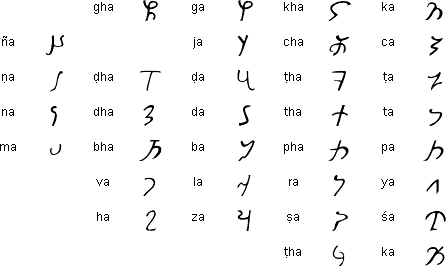

Sample text

Links
Kharosthi information (includes free Kharosthi font)
http://depts.washington.edu/ebmp/software.html
http://depts.washington.edu/ebmp/software.html
Kharosthi Unicode proposal submitted by Andrew Glass, Stefan Baums, and Richard Salomon - the above script chart and text sample is based on this
http://std.dkuug.dk/jtc1/sc2/wg2/docs/n2524.pdf
http://std.dkuug.dk/jtc1/sc2/wg2/docs/n2524.pdf
A Preliminary Study of Kharosthi Manuscript Paleography, by Andrew Glass
http://depts.washington.edu/ebmp/downloads/Glass_2000.pdf
http://depts.washington.edu/ebmp/downloads/Glass_2000.pdf
ALPHABETUM - a Unicode font specifically designed for ancient scripts, including classical & medieval Latin, ancient Greek, Etruscan, Oscan, Umbrian, Faliscan, Messapic, Picene, Iberian, Celtiberian, Gothic, Runic, Old & Middle English, Hebrew, Sanskrit, Old Nordic, Ogham, Kharosthi, Glagolitic, Old Cyrillic, Phoenician, Avestan, Ugaritic, Linear B, Anatolian scripts, Coptic, Cypriot, Brahmi, Old Persian cuneiform:http://guindo.pntic.mec.es/~jmag0042/alphabet.html
Writing system used to write Sanskrit
Item 1. BVSubbarayappa the Rigvedic People Their Identity 1995, in LK Srinivasan and S. Nagaraju, eds., Sri Nagabhinandanam Dr. MS Nagaraja Rao Festschrift, Bangalore, Dr. MS Nagaraja Rao Felicitation Committee, pp. 83-97
http://www.scribd.com/doc/138058489/BVSubbarayappa-the-Rigvedic-People-Their-Identity-1995
Item 2. BVSubbaryappa Indus Numeration QJMS Vol 100 No 4 Oct Dec 2009 Indus numeration, inscriptional confirmatory evidence in Quarterly Journal of Mythical Society, Vol. 100 No. 4, Oct. - Dec. 2009
http://www.scribd.com/doc/138059142/BVSubbaryappa-Indus-Numeration-QJMS-Vol-100-No-4-Oct-Dec-2009
Item 3. Subhash Kak, 1994, Evolution of early writing in India, IJHS 29(3), 1994
http://www.scribd.com/doc/138057508/Subhash-Kak-Evolution-of-Writing-in-India-IJHS-29-3-1994



